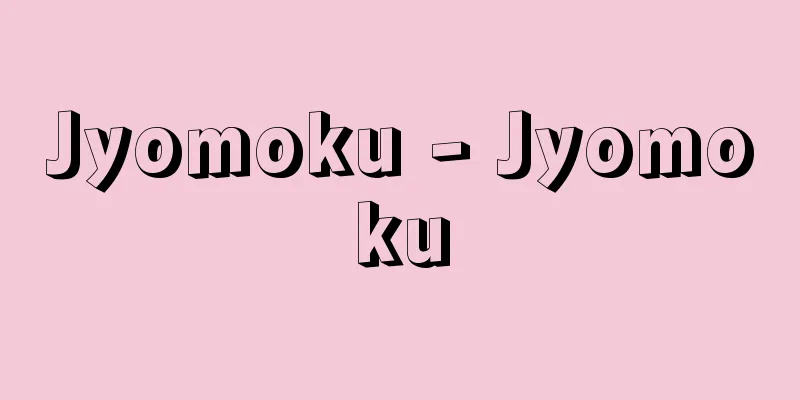Jyomoku - Jyomoku

|
Originally, it was called jinkan, which means the government affairs of appointing officials. Appointing an official is called jo, which means leaving one's current position to take up a new one. In China, jomoku (josho) is the official appointment letter, but in Japan, the ceremony for appointment was called jimoku. Regular ceremonies include gekan jomoku and kyokan jomoku, the former of which was mainly for appointing local officials, and was also called agatemashi jomoku from the Middle Ages onwards. The ceremonies are said to start on the 9th (later the 11th) of the New Year in the book of ceremonies, but in reality, this is not fixed. It is held over three nights. The latter of which was mainly for appointing officials of the central government, and was also called tsukasameshi jomoku in contrast to kensho, and was originally held in the spring, but later took place in autumn and winter, with one night as the rule. The appointment of new officials is carried out by the Emperor in person, with the nobles (kugyo) and others gathering at Seiryoden (or at the regent's direct chambers (chokuro/jikiro)). In principle, the person in charge is the chief minister, and the appointment is recorded in the Omagaki (a book of official documents), which is called Shippitsu (writing). Regarding the contents of the appointment of foreign officials, the first night began with the appointment of lower-ranking officials with many years of service (years of service) who worked in the Naijudokoro and other places, and applicants who applied through the annual salary (right of recommendation given annually to the Emperor, the Emperor's Imperial Court, the Imperial Prince, the nobles, etc.), to Jo and Sakan in various provinces, before moving on to higher-ranking appointments. The second night included the appointment of prominent officials to important government offices, such as Geki, Shikibu, Minbu no Jo, and Saemon no Jo, and the third night covered the appointment of Zuryo and nobles. Ministers are appointed by the Emperor's decree in a separate ceremony called Daijinmeshi, and are not appointed through the appointment of officials. The ceremony for conferring an ambassador was extremely complicated and respected precedent, and continued to exist as a court ritual into the early modern period even after aristocratic politics had lost its substance. The order of the ceremony is described in detail in Oe no Masafusa's Gokeshidai, and other important documents include Jome Taiseisho, Gyorogusho, and Jomesho. Going back in time, Emperor Godaigo's Kenmu Nenchu Gyoji is written in kana and is easy to understand. There are also special Jome (small Jome), Nyokan Jome, and Ichibumeshi (appointments to positions such as Shisho in various provinces), and sometimes investiture is also carried out at the same time. Also, Naoshimono (presentations) are often carried out after Jome. [Nobuo Kuroita] Source: Shogakukan Encyclopedia Nipponica About Encyclopedia Nipponica Information | Legend |
|
本来は任官といい、官職任命の政務。官に任ずることを除(じょ)といい、もとの官を去って新しい官につく意。中国で除目(じょもく)(除書(じょしょ))というのは任官の辞令であるが、日本では任官の行事を除目(じもく)と称した。定例のものに外官(げかん)除目、京官(きょうかん)除目があり、前者はおもに地方官を任ずるもので、中世以降は県召(あがためし)除目ともよばれた。儀式書では正月9日(のちには11日)よりとされるが、現実には一定していない。三夜にわたり行われる。後者はおもに中央諸司の官を任ずるもので、県召に対して司召(つかさめし)除目ともいい、初めは春の行事とされたが、のちには秋から冬に行われ、一夜が原則であった。除目は天皇親臨のもとに公卿(くぎょう)以下清涼殿(せいりょうでん)(摂政(せっしょう)が行う場合はその直廬(ちょくろ/じきろ))に参集し行われる。最高責任者は首席の大臣が務めるのが原則で、任官者を大間書(おおまがき)に記入していくので執筆(しっぴつ)という。 内容を外官除目についてみると、第一夜は四所籍(ししょのしゃく)といって内豎所(ないじゅどころ)などに勤める下級の職員の年労(勤続年数)の多い者や、年給(ねんきゅう)(天皇、院、宮、公卿などに毎年給せられる推挙権)による申請者を諸国の掾(じょう)、目(さかん)に任ずることから始めて、上位の任官に進む。第二夜には外記(げき)、史、式部、民部の丞(じょう)、左右衛門尉(じょう)など重要な官司の実務官を任ずる顕官挙(けんかんのきょ)なども行われ、第三夜では受領(ずりょう)や公卿の任官に及ぶ。なお大臣は、別に大臣召(だいじんめし)という儀式で天皇の宣命(せんみょう)によって任ぜられ、除目では任官されない。除目の作法は先例尊重の非常に繁雑なもので、公家(くげ)政治が実質を失っても朝廷の儀式として近世まで存続する。 儀式の次第は大江匡房(おおえのまさふさ)の『江家次第(ごうけしだい)』がとくに詳しく、『除目大成抄(じもくたいせいしょう)』『魚魯愚抄(ぎょろぐしょう)』『除目抄(じもくしょう)』なども重要な文献である。時代が下るが後醍醐(ごだいご)天皇の『建武年中行事(けんむねんじゅうぎょうじ)』は仮名書きであるのでわかりやすい。なお除目には臨時除目(小除目(こじもく))、女官(にょかん)除目、一分召(いちぶめし)(諸国の史生(ししょう)などの任官)などがあり、叙位がいっしょに行われる場合もある。また除目のあとに直物(なおしもの)が行われることが多い。 [黒板伸夫] 出典 小学館 日本大百科全書(ニッポニカ)日本大百科全書(ニッポニカ)について 情報 | 凡例 |
<<: Jimokuji [town] - Jimokuji
Recommend
Carpentelles
… P . notatum and P. chrysogenum are bacteria tha...
smørrebrød (English spelling) smorrebrod
…In contrast to the above, an open sandwich is on...
Raetia - Raetia (English spelling)
The name of the province of the Alps under the rul...
Yame paper - Yamegami
Strong kozo paper is made in Yame City, Fukuoka Pr...
Molasses Act
The British Parliament passed an act in December 1...
Apis
… [The cow as a symbol] The following theory by E...
Regal
…There are various sizes of organs depending on t...
Schizaster pacificus (English spelling) Schizasterpacificus
…Sea urchin [Minoru Imajima]. . . *Some of the te...
Merton, Thomas
Born January 31, 1915, Basque, Prahlad [Died] Dece...
The power of the keys
…In the late Middle Ages in Germany, after the ti...
deontology
…There have been two contrasting tendencies since...
Carcharhinus falciformis (English spelling)
…Shark [Toru Taniuchi]. . . *Some of the terminol...
Sodium cyclohexylsulfamate
…Sodium cyclohexylsulfamate (also called sodium c...
Wagner, S.
...German composer. His librettos for music drama...
Endemoconus sieboldi (English spelling) Endemoconussieboldi
…The operculum is usually smaller than that of th...









